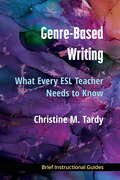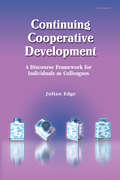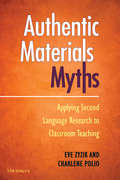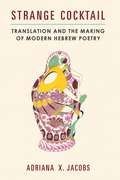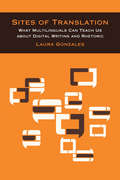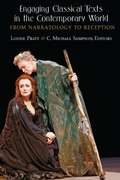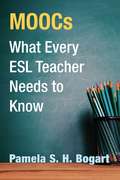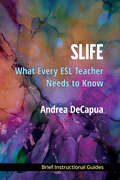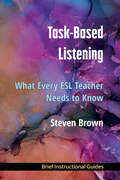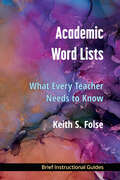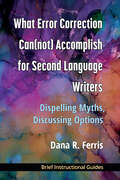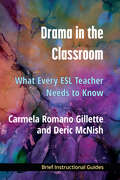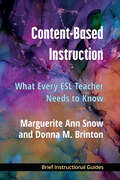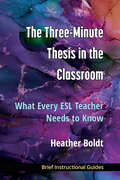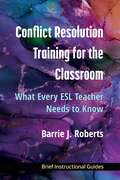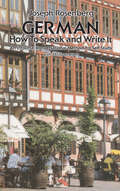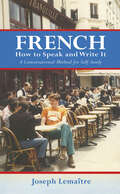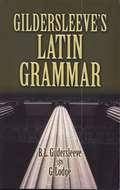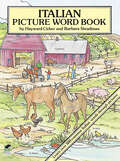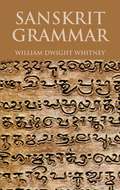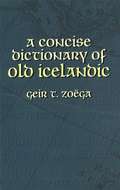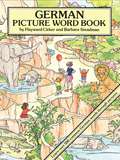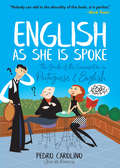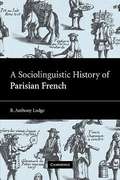- Table View
- List View
Genre-Based Writing: What Every ESL Teacher Needs to Know
by Christine TardyIn Genre-Based Writing, author Christine Tardy defines genre and genre-based writing instruction and the five principles of a genre-based pedagogy. She then explains how to design genre-based writing activities. By discussing the genre-related practices and social and rhetorical aspects of genre, she is able to outline strategies for exploring rhetorical moves and playing with genre form in the classroom. In addition, the book provides general tips for bringing a genre approach into the writing classroom as well as several application activities and specific suggestions for classroom tasks.
Continuing Cooperative Development: A Discourse Framework for Individuals as Colleagues
by Julian EdgeIn Continuing Cooperative Development, a series of guided tasks helps the reader acquire specific skills of listening and responding that, in turn, help a speaker to express and articulate thoughts and plans that lie just beyond what they knew that they knew. By adopting a certain style of speaking and listening to colleagues for agreed periods of time, motivated professionals can take individual control of their own development and increase the feeling of collegiality in their workplace. Continuing Cooperative Development draws on Edge's experience of more than ten years using this framework worldwide and provides authentic examples to guide the reader. This interactive framework is demonstrated in the book as part of a reflective teaching approach in response to everyday classroom problems, and also as part of a more formal, action-research approach to the formulation of local educational theory. The key theme of this book is the power of non-judgmental discourse to facilitate the development of ideas and action, accessing both cognitive and emotional intelligence. The transcribed and interpreted data of authentic interactions from the Americas, Europe, and Asia serve as evidence for the argument and as guidelines for implementation. The work is set in the field of TESOL, although its relevance reaches across discipline boundaries. The teachers featured in the book have duties ranging from the instruction of young learners to the supervision of doctoral research. The common denominator is that these people are motivated educators, committed to extending their own understanding and developing their own style of being an aware professional.
Authentic Materials Myths: Applying Second Language Research to Classroom Teaching
by Eve Zyzik Charlene PolioThe use of authentic materials in language classrooms is sometimes discussed as a reliable way to expose students to the target language, but there is also disagreement regarding what kinds of authentic materials should be used, when they should be used, and how much of the curriculum should revolve around them. This volume in the Myths series explores the research related to the use of authentic materials and the ways that authentic materials may be used successfully in the classroom. Like others in the Myths series, this book combines research with good pedagogical practices. The myths examined in this book are: Authentic texts are inaccessible to beginners. Authentic texts cannot be used to teach grammar. Shorter texts are more beneficial for language learners. Activating background knowledge or making a word list is sufficient to prepare students for authentic texts. Authentic texts can be used to teach only listening and reading. Modifying or simplifying authentic texts always helps language learners. For learners to benefit from using authentic texts, the associated tasks must also be authentic. The Epilogue explores the challenges of using authentic texts in the classroom and calls for more research.
Strange Cocktail: Translation and the Making of Modern Hebrew Poetry (Michigan Studies In Comparative Jewish Cultures)
by Adriana X. JacobsFor centuries, poets have turned to translation for creative inspiration. Through and in translation, poets have introduced new poetic styles, languages, and forms into their own writing, sometimes changing the course of literary history in the process. Strange Cocktail is the first comprehensive study of this phenomenon in modern Hebrew literature of the late nineteenth century to the present day. Its chapters on Esther Raab, Leah Goldberg, Avot Yeshurun, and Harold Schimmel offer close readings that examine the distinct poetics of translation that emerge from reciprocal practices of writing and translating. Working in a minor literary vernacular, the translation strategies that these poets employed allowed them to create and participate in transnational and multilingual poetic networks. Strange Cocktail thereby advances a comparative and multilingual reframing of modern Hebrew literature that considers how canons change and are undone when translation occupies a central position—how lines of influence and affiliation are redrawn and literary historiographies are revised when the work of translation occupies the same status as an original text, when translating and writing go hand in hand.
Sites of Translation: What Multilinguals Can Teach Us about Digital Writing and Rhetoric (Sweetland Digital Rhetoric Collaborative)
by Laura GonzalesWinner of the 2016 Sweetland Digital Rhetoric Collaborative Book Prize Sites of Translation illustrates the intricate rhetorical work that multilingual communicators engage in as they translate information for their communities. Blending ethnographic and empirical methods from multiple disciplines, Laura Gonzales provides methodological examples of how linguistic diversity can be studied in practice, both in and outside the classroom, and provides insights into the rhetorical labor that is often unacknowledged and made invisible in multilingual communication. Sites of Translation is relevant to researchers and teachers of writing as well as technology designers interested in creating systems, pedagogies, and platforms that will be more accessible and useful to multilingual audiences. Gonzales presents multilingual communication as intellectual labor that should be further valued in both academic and professional spaces, and supported by multilingual technologies and pedagogies that center the expertise of linguistically diverse communicators.
Engaging Classical Texts in the Contemporary World: From Narratology to Reception
by Louise H. Pratt C. M SampsonContemporary classicists often find themselves advocating for the value and relevance of Greco-Roman literature and culture, whether in the classroom, or social media, or newsprint and magazines. In this collection, twelve top scholars apply major critical approaches from other academic fields to open new channels for dialogue between ancient texts and the contemporary world. This volume considers perennial favorites of classical literature—the Iliad and Odyssey, Greek tragedy, Roman comedy, the Argonautica, and Ovid’s Metamorphoses—and their influence on popular entertainment from Shakespeare’s plays to Hollywood’s toga films. It also engages with unusual and intriguing texts across the centuries, including a curious group of epigrams by Artemidorus found on the island sanctuary of Thera, mysterious fragments of two Aeschylean tragedies, and modern-day North African novels. These essays engage an array of theoretical approaches from other fields—narratology, cognitive literary theory, feminist theory, New Historicist approaches to gender and sexuality, and politeness theory—without forsaking more traditional philological methods. A new look at hospitality in the Argonautica shows its roots in the changed historical circumstances of the Hellenistic world. The doubleness of Helen and her phantom in Euripides’ Helen is even more complex than previously noted. Particularly illuminating is the recurrent application of reception studies, yielding new takes on the ancient reception of Homer by Apollonius and of Aeschylus by Macrobius, the reception of Plautus by Shakespeare, and more contemporary examples from the worlds of cinema and literature. Students and scholars of classics will find much in these new interpretations and approaches to familiar texts that will expand their intellectual horizons. Specialists in other fields, particularly English, comparative literature, film studies, and gender and sexuality studies, will also find these essays directly relevant to their work.
MOOCs: What Every ESL Teacher Needs to Know
by Pamela BogartPamela Bogart, an instructor at the University of Michigan's English Language Institute, explains the ins and outs of massive open online courses (MOOCs), particularly those that can support language learning. The author begins by describing what a MOOC is; she then identifies the various types of MOOCs and their pedagogical benefits and shows how MOOCs can aid in the language learning process and offer students a more richly textured blended learning experience. The text concludes with tips for creating and designing a MOOC. Each section includes an Exploration Task that invites readers to deepen their personal understanding of and experience with MOOCs.
SLIFE: What Every Teacher Needs to Know
by Andrea DeCapuaSLIFE: What Every Teacher Needs to Know helps readers deepen their understanding of Students with Limited or Interrupted Formal Education (SLIFE). Because of their limited, greatly interrupted, or sometimes nonexistent participation in formal education, SLIFE face challenges in the classroom that go beyond language and content. Often SLIFE need to develop basic literacy skills and foundational subject-area knowledge, as well as to learn how to engage in the discourse and practices of formal educational settings. So what can teachers do to help these students succeed and to recognize and honor their knowledge, skills, and cultural capital? SLIFE: What Every Teacher Needs to Know centers around four guidelines for teaching SLIFE: question assumptions, foster two-way communication, explicitly teach school tasks and academic ways of thinking, and promote project-based learning. Discussion of the Mutually Adaptive Learning Paradigm (MALP), is also included.
Task-Based Listening: What Every ESL Teacher Needs to Know
by Steven BrownAre you looking for activities to use in your listening classes beyond asking students to answer comprehension questions? In Task-Based Listening, author Steven Brown defines task-based listening (TBL) and describes how to build a task-based listening program, how to create a task-based listening lesson, ways to activate vocabulary acquisition and improve grammatical knowledge, and the links between listening and pronunciation. In addition, he covers the ways that metacognitive strategies can assist students when listening, the advantages of extensive listening, and the benefits of interactive listening. Readers will find specific tips and suggestions for using these concepts in the classroom.
Academic Word Lists: What Every Teacher Needs to Know
by Keith S. FolseIn Academic Word Lists, Keith Folse explains how various lists like the Academic Word List (AWL) have become popular tools in the ESL classroom for teaching vocabulary. Following a discussion on the importance of teaching vocabulary, Folse explains why word lists are useful in language learning and how they can help address the lexical gap. He also outlines what words are on the AWL, how the word families are selected, and what teachers should know about other word lists. The book also includes 10 suggestions for using academic word lists in the classroom, including how to use vocabulary notebooks.
What Error Correction Can(not) Accomplish for Second Language Writers: DIspelling Myths, Discussing Options
by Dana R. FerrisThis book looks at aspects of L2 research that influence error correction, finding that second language acquisition takes time and that second language writers' texts differ from those written by native English speakers. Using this research, Dana R. Ferris dispels the myth that diligent teacher correction and student editing can lead to perfect, error-free texts. In clear and simple terms, Ferris makes six suggestions for things teachers can do in the classroom regarding error correction and provides samples. Other issues regarding the expectations of students and others—such as in timed (high-stakes) situations—as it relates to "perfect" papers are examined. The book closes by addressing the basic principles of developing students' language skills in second language/ESL writing classes.
Drama in the Language Classroom: What Every ESL Teacher Needs to Know
by Carmela Romano Gillette Deric McNishDrama in the Language Classroom weaves together cutting-edge research and practices from the fields of theater and TESOL. After providing an overview of how drama can be used in the language classroom, Carmela Romano Gillette (a TESOL expert) and Deric McNish (an expert in actor training) present a collection of resources teachers need to begin using drama, including practical classroom-tested and evidence-based techniques. They show how theater, performance, and improvisation can help students build confidence, develop a deeper context for speaking, and create authentic opportunities for language use. In addition, they outline the para- and extra-linguistic techniques that can improve expression and meaningful communication. Each section includes sample activities, such as script analysis for improving fluency, and assessment suggestions. Readers do not need to have experience with performance or drama to learn how to incorporate these practices into the ESL classroom.
Content-Based Instruction: What Every ESL Teacher Needs to Know
by Ann Snow Donna BrintonThis book introduces readers to the concept of Content-Based Instruction (CBI) through a brief history and countless examples of the many ways this approach can be applied across settings and programs. Whether readers want to deepen their understanding of CBI or get ideas for their own teaching situation, this book provides an overview of CBI and the process of implementing it. The book discusses the three prototype models (theme-based, sheltered, and adjunct), new models (sustained content language teaching, content and language-integrated learning, English-medium instruction, adjunct models, and other hybrid models), and a research-based rationale for using CBI in the classroom. Each section includes reflection questions designed to guide readers to consider how best to implement CBI in their course and program.
Genre-Based Writing: What Every ESL Teacher Needs to Know
by Christine TardyIn Genre-Based Writing, author Christine Tardy defines genre and genre-based writing instruction and the five principles of a genre-based pedagogy. She then explains how to design genre-based writing activities. By discussing the genre-related practices and social and rhetorical aspects of genre, she is able to outline strategies for exploring rhetorical moves and playing with genre form in the classroom. In addition, the book provides general tips for bringing a genre approach into the writing classroom as well as several application activities and specific suggestions for classroom tasks.
The Three Minute Thesis in the Classroom: What Every ESL Teacher Needs to Know
by Heather BoldtThe Three Minute Thesis (3MT®) competition is an annual academic speaking competition that challenges graduate students to present their thesis and its significance to a non-specialist audience in just three minutes. In The Three Minute Thesis in the Classroom, author Heather Boldt focuses on how the 3MT can be used in an ESL or EAP classroom to improve students' speaking skills, particularly about research. This Brief Instructional Guide uses data from the author's corpus of 3MT transcripts to reveal the six moves typical of this type of presentation and then provides instructors with a variety of classroom applications in the areas of vocabulary, pronunciation, describing research to non-specialists, and effective slide design.
Conflict Resolution Training for the Classroom: What Every ESL Teacher Needs to Know
by Barrie RobertsESL instructors without a background in conflict resolution (CR) who teach intermediate to advanced courses at colleges, universities, or in Intensive English Programs, may want to provide students with valuable negotiation and mediation skills. Author Barrie J. Roberts is an experienced ESL teacher, lawyer, mediator, and Alternative Dispute Resolution (ADR) Administrator for southern California Superior Courts. In this book, she draws upon her experience using these activities in a variety of ESL settings and courses with students from all over the world to inspire other ESL teachers to add CR approaches to their activities, lessons, and courses. Following an introduction to conflict resolution, Conflict Resolution Training for the Classroom shows how much of the teaching of CR is similar to teaching ESL. It outlines ways to apply negotiation and mediation to ESL activities, how to prevent and resolve conflicts, how to use specific types of role-plays to address conflicts, and how to design successful activities. The book also includes a list of resources and sample syllabi.
German: How to Speak and Write It
by Joseph RosenbergThis is probably the most delightful, useful, and comprehensive elementary book available for learning spoken and written German, with or without a teacher. Working on the principles that a person learns more quickly by example than by rule, the author has put together a book that abounds in immediately usable German sentences and phrases on a wide variety of subjects.The student will find pleasure in the amusing sketches and drawings used to imbed new vocabulary firmly in the student's mind, in the many excellent photographs of cities and landmarks in German-speaking countries, and in the glimpses of German culture and custom subtly interwoven into the conventional material.The book, though eminently useful for self-study, is especially amenable to classroom use or study with a private tutor. The variety of teaching aids that this book places at the teacher's disposal is remarkable. The lessons contain dialogues, grammar and idiom studies (replete with examples), and extensive practice exercises. In addition there are 28 full-page and double-page sketches of specific scenes (a harbor, a zoo, a theatre, etc.) with pertinent items numbered and identified in German and English; sketches and photographs, which the student is asked to describe in German; German proverbs, jokes, and more.The dialogues and reading material encompass an exceptionally wide range of real-life situations, and are extended to include most of the basic vocabulary one would need in each situation. The analysis of German pronunciation is very comprehensive (and the simple phonetic system used in the early stages is readable by sight). The practice exercises are carefully designed to allow the student to use what he learned. The closing sections contain a summary of grammar, a guide to letter writing (with sample German letters), and a valuable study guide to German literature by Dr. Richard Friedenthal.The book differs from others of its type in that it gives more attention to the elementary stages of learning, and the rate of progress is less rapid than usual. This means that any intelligent person, even if he is an absolute beginner, can with sufficient application arrive at the end of the course confident of having acquired a solid foundation for further study.
French: How to Speak and Write It (Dover Language Guides French)
by Joseph LemaîtreProbably the most delightful, useful, and comprehensive elementary book available for learning spoken and written French, either with or without a teacher. Working on the principle that a person learns more quickly by example then by rule, Lemaître has assembled colloquial French conversations on a variety of subjects, as well as grammar, vocabulary, and idiom studies. Index.
Gildersleeve's Latin Grammar
by G. Lodge B. L. GildersleeveSince 1867, students of Latin and their teachers have turned to this famous guide for instruction on grammar and usage. The work of a distinguished professor who taught classics for six decades, it is celebrated for its lucid and comprehensive treatment.The first third of the text focuses on etymology, exploring inflections of the substantive and adjective; adverbs, numerals, and pronouns; inflection of the verb; and the formation of words. Subsequent chapters advance to syntax, examining simple and compound sentences; the arrangement of words and clauses; figures of syntax and rhetoric; and principal rules of syntax. The text concludes with an extended section on prosody that discusses and illustrates the conventions of Latin verse. Helpful indexes feature information on everyday Roman life, including explanations of the calendar, weights and measures, money, and names. No Latin reference collection is complete without this volume, which is equally useful for classroom and independent study.
Italian Picture Word Book
by Barbara Steadman Hayward CirkerHere’s a pleasant and effective way for students of Italian to build and strengthen vocabulary skills. The book consists of 15 carefully rendered scenes (14 double-page and one single-page), each devoted to a different theme or topic.Lo zoo: At the zooLa fattoria: On the farmLa camera di una ragazza: Girl’s bedroomLa camera di un ragazzo: Boy’s bedroomL’aula scolastica: ClassroomIl soggiorno: Living roomIl bagno: BathroomL’ora di pranzo: At dinnerIl supermercato: SupermarketLa spiaggia: At the beach… and five more.Each illustration contains dozens of common objects, clearly labeled in Italian. By studying the illustrations, students can learn over 500 words for common household items, clothing, foods, vehicles, furniture, names of animals, parts of the body, types of stores and public buildings, and much more.To help reinforce words and meanings, all the scenes in this book are ideal for coloring. In addition, a complete list of Italian words (with definite articles) and English translations will be found at the back of the book. The result is an attractive and useful language resource that will appeal to any student of basic Italian, child or adult.
Sanskrit Grammar
by William Dwight WhitneyAs Latin is key to the study of Western classics, so Sanskrit is the gateway to understanding ancient Indian literature. One of the few Sanskrit grammars currently available, this meticulously researched and thoughtfully assembled guide to the language's basics will prove valuable to students of Indian culture and history.Focusing on the fundamentals of Sanskrit as revealed in literary classics, the text follows the forms and constructions of the older language, as exhibited in the Veda and the Brahamana. It begins with an introduction to the Sanskrit alphabet, followed by a treatment of the accent -- its changes in combination and inflection, and the tone of the individual worlds. Succeeding chapters discuss declension, conjugation, parts of speech, and formation of compound stems. A helpful appendix, Sanskrit index, and general index conclude the text.
A Concise Dictionary of Old Icelandic
by Geir T. ZoëgaModern Icelandic is closer to the speech patterns of the Middle Ages than any living European language. Thus, a knowledge of Icelandic is highly relevant to the study of English history. This volume, one of the most complete available, will be indispensable to scholars of medieval Icelandic and English culture and history.
German Picture Word Book
by Barbara Steadman Hayward CirkerHere's a pleasant and effective way for students of German to build and strengthen vocabulary skills. The book consists of 15 carefully rendered scenes -- 14 double-page and one single-page -- each devoted to a different theme of topic: Im Zoo (At the Zoo); Das Wohnzimmer (Living Room); Auf dern Bauernhof (On the Farm); Das Badezimmer (Bathroom); Das Schlafzimmer des Mädchens (Girl's Bedroom); Beim Abendessen (At Dinner); Das Schlafzimmer des Jungens (Boy's Bedroom); Der Supermarkt (Supermarket); Das Klassenzimmer (Classroom); Am Strand (At the Beach); and 5 more.Each illustration contains dozens of common objects, clearly labeled in German. By studying the illustrations, students can learn over 500 words for common household items, clothing, foods, vehicles, furniture, names of animals, parts of the body, types of stores and public buildings, and many more.To help reinforce words and meanings, all the scenes in this book are ideal for coloring. In addition, a complete list of German words (with definite articles) and English translations will be found at the back of the book. The result is an attractive and useful language resource that will appeal to any student of basic German, child or adult.
English as She Is Spoke: The Guide of the Conversation in Portuguese and English
by Mark Twain Pedro CarolinoThe Guide of the Conversation in Portuguese and English
A Sociolinguistic History Of Parisian French (PDF)
by R. Anthony LodgeParis mushroomed in the thirteenth century to become the largest city in the Western world, largely through in-migration from rural areas. The resulting dialect-mixture led to the formation of new, specifically urban modes of speech. From the time of the Renaissance social stratification became sharper as the elites distanced themselves from the Parisian 'Cockney' of the masses. Nineteenth-century urbanisation transformed the situation yet again with the arrival of huge numbers of immigrants from far-flung corners of France, levelling dialect-differences and exposing ever larger sections of the population to standardising influences. At the same time, a working-class vernacular emerged which was distinguished from the upper-class standard not only in grammar and pronunciation but most markedly in vocabulary (slang). This book examines the interlinked history of Parisian speech and the Parisian population through these various phases of in-migration, dialect-mixing and social stratification from medieval times to the present day.
